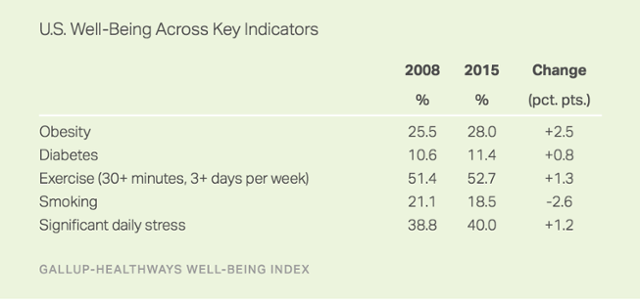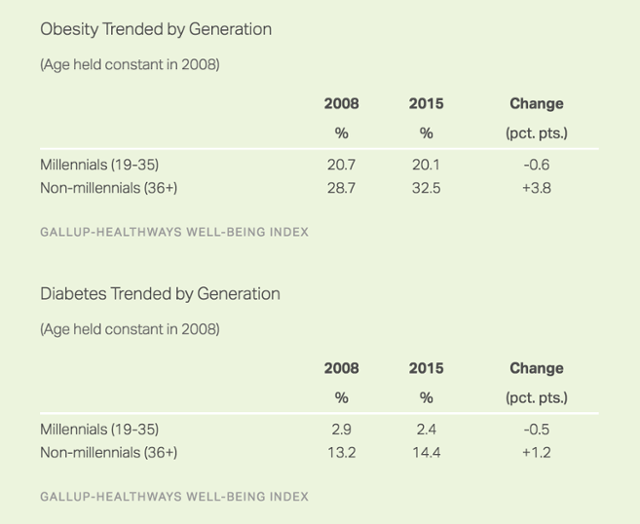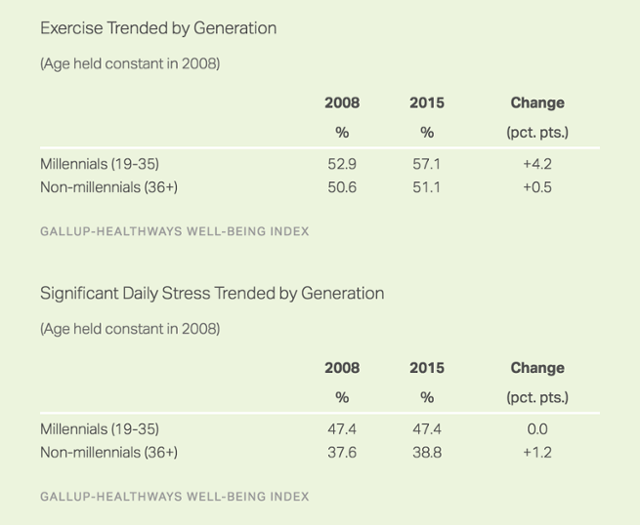STORY HIGHLIGHTS
- Obesity up in U.S. since 2008; more than one in six still smoke
- Obesity and smoking negatively affect the U.S. economy
- Among millennials, obesity and smoking are down, exercise is up
This is the first article in a two-part series.
Americans have major well-being problems — and some are causing significant harm to the country’s economy.
According to the Gallup-Sharecare Well-Being Index, the obesity rate among American adults is 28%, while diabetes tops 11%. Nearly one in five smoke, two in five experience significant daily stress, and almost half do not exercise for 30 minutes or more at least three days per week. And several of these indicators have remained unchanged or have worsened since 2008.
The implications of these results are very real — and are significant for the U.S. economy. Adults who are overweight accumulate about $378 more per person each year in healthcare costs, while those who are obese cost an astonishing $1,580 more per person each year. Taken together, above-normal-weight adults in the U.S. add more than $142 billion each year in incremental healthcare costs.
Smoking, in turn, is even more costly per person. Adults who smoke accrue, on average, $2,132 more each year in healthcare costs than nonsmokers, adding another $92 billion. And together, overweight or obese Americans who smoke add an astonishing $235 billion in unnecessary healthcare costs each year.
But the story doesn’t end there. Obesity and smoking degrade employees’ health, elevating unplanned absenteeism in the workplace and reducing overall productivity. Assuming that every eight hours of unplanned missed work costs $344 in lost productivity, the combination of obesity and smoking among U.S. workers causes an estimated $257 billion of lost economic activity each year.
So, coupled together — and limiting the analysis only to unnecessary healthcare costs and incremental unplanned absences — obesity and smoking are needlessly costing the U.S. economy nearly a half-trillion dollars annually.
Five Well-Being Elements Are Interrelated
All of these metrics are part of the Gallup-Sharecare Well-Being Index, an ongoing national poll of U.S. adults measuring five interrelated elements:
- Purpose: liking what you do each day and being motivated to achieve your goals
- Social: having supportive relationships and love in your life
- Financial: managing your economic life to reduce stress and increase security
- Community: liking where you live, feeling safe and having pride in your community
- Physical: having good health and enough energy to get things done daily
Research has shown that thriving in all five elements consistently yields better outcomes than physical wellness alone, and that metrics from one element can influence well-being in another. For example, obesity is linked to lower social well-being, while poor financial well-being is — along with other risk factors — related to obesity. Smokers, in turn, are more likely to experience negative emotions on any given day.
Millennial Well-Being May Be Turning the Tide
The good news is that millennials — America’s youngest generation of adults and workers, born between 1980 and 1996 — appear to be helping national well-being and the economic engine they so significantly influence.
Since 2008, obesity has climbed by at least three percentage points for all generations exceptmillennials, for whom obesity has actually declined by more than 0.5 points. Diabetes diagnoses have also decreased for millennials — by 0.5 points in 2015, compared with the 19- to 35-year-old group in 2008 — while they have continued to increase among all other generations.
Millennials are also taking a leading role in other key aspects of well-being. Exercise, which is essential for preventing obesity and managing daily stress, has climbed substantially since 2008 among millennials, compared with virtually no change among non-millennials. Reports of significant daily stress — which generally decrease with age — have climbed since 2008 among all generations except millennials. Consistent with their age, millennials’ stress rates are higher, but the rate of change from 2008 to 2015 is flat.
Although the nation’s youngest adults are historically the generation most likely to smoke, millennials — coupled with Gen Xers — have taken the lead in Americans’ overall drop in smoking over the past several years. The two youngest adult generations have reduced their respective smoking rates by more than three percentage points. Combined, they have decreased their smoking rate at twice the pace of their older counterparts since 2008.
The next article in this series shows what leaders can do to harness and amplify millennials’ well-being.
SURVEY METHODS
Results are based on telephone interviews conducted Jan. 2-Dec. 30, 2008, and Jan. 2-Dec. 29, 2015, as part of the Gallup-Sharecare Well-Being Index survey, with a random sample of 341,650 adults in 2008 and 174,387 adults in 2015, aged 18 and older, living in all 50 U.S. states and the District of Columbia. About 30,000 respondents aged 19 to 35 were surveyed each year. For results based on the total sample of national adults, the margin of sampling error is ±0.2 percentage points at the 95% confidence level. For any given generation, the margin of error is no greater than ±0.5 percentage points.
Each sample of national adults in 2015 included a minimum quota of 60% cellphone respondents and 40% landline respondents, with additional minimum quotas by time zone within region. Landline and cellular telephone numbers were selected using random-digit-dial methods. In 2008, 85% of all respondents were interviewed via landline and 15% via cellphone.


